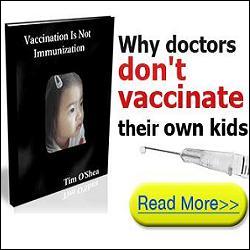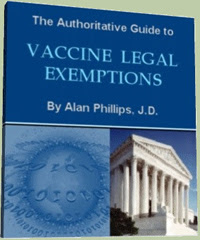 Missy Fluegge
Missy Fluegge
Activist Post
A doctor from the Children’s Hospital in Colorado is working on a bold new initiative to improve the lives of children in Guatemala who struggle with poverty and hunger each day. Unfortunately, his ambitions do not include plans to provide clean water or education.
Instead, he plans to implement a mobile short message service (SMS) to send text messages to parents to remind them to vaccinate their children, in a nation where beans have become a luxury rather than a daily staple, and farmers must sell their eggs and vegetables to provide for their families. [1]
In 2009, some of the world’s richest countries agreed to provide $20 billion in aid to Guatemala to improve food security by teaching people how to employ sustainable agriculture methods, a measure which is desperately needed to lift this struggling nation out of poverty. President Barack Obama stated that the “purpose of aid must be to create the conditions where it’s no longer needed, to help people become self-sufficient, provide for their families and lift their standards of living.” [2]
The Struggles Many People Face in Guatemala
This tropical Central American country is bordered by Mexico, Belize, Honduras, El Salvador, the Pacific Ocean, and the Caribbean Sea. It has a population of 12.7 million people. The country is ranked among the top five biodiversity hotspots in the world. [3]
Guatemala’s people face high levels of serious socioeconomic ills, including income disparity, malnutrition, illiteracy, infant mortality, infrastructure concerns, and corruption.
The country’s poorest citizens live in rural areas like peasants, while the wealthiest people live in luxurious, country-club style neighborhoods. Statistics from Guatemala’s own government state that seventy percent of its native population lives in poverty. [4]
According to a United Nations report, non-indigenous people live, on average, thirteen years longer than their indigenous counterparts. Indigenous people comprise sixty percent of Guatemala’s population. [5]
Guatemala’s thirteen million citizens face the sixth worst rate of malnutrition in the world, with malnutrition rates in some areas of the country reaching ninety percent. Despite having a prosperous lower middle class, the country’s wealth is disproportionately divided to the extreme, with almost half of the nation’s children living with chronic malnutrition. Forty percent of citizens here survive on less than $1 per day. [6]
According to a 2007 report by the U.S. Agency for International Development, at Guatemala’s current slow rate of progress, it would take 83 years to put an end to stunting among the country’s indigenous populations.
The list of grave problems that affect the Guatemalan people is longer than just malnutrition and poverty. Over sixty percent of indigenous women are illiterate, despite the Latin American region boasting an very impressive overall literacy rate of 85 percent.
Like education, clean water and electricity are in very short supply, if they exist at all, in many villages.
Finally, while the country continues to slowly recover from a thirty-year civil war, its government still struggles with corruption, poor law enforcement, and a lack of support for the poor.
Important Steps to Create Change
 The government of Guatemala has made efforts to address poverty-related issues, but the food supplements they offer to growth-stunted babies are merely a small bandage on a very deep wound.
The government of Guatemala has made efforts to address poverty-related issues, but the food supplements they offer to growth-stunted babies are merely a small bandage on a very deep wound.
The director of the nation’s food security and nutrition agency, Juan Aguilar, identified the need for basic infrastructure improvements in villages, so the government created an initiative to do just that, but its budget is too small to effectively address such huge needs. Aguilar stated, that if he had more funding to help his fellow citizens, “there is no doubt I would put it into water and sanitation.” [7]
With knowledge of these sad statistics, government leaders from around the world, including leaders in Guatemala itself, have identified a list of the most effective ways to improve the lives of people who live in poverty, in a nation with a healthy gross domestic product and good economy. They did not mention a system to provide text messages to parents telling them to vaccinate their children.
The Man and His Misguided Mission
Dr. Edwin Asturias, Assistant Professor of Pediatrics in the pediatric infectious disease department at the University of Colorado, is the leader of the text message initiative. He works for Children’s Hospital in Colorado, and he is also Assistant Professor of Epidemiology at the Colorado School of Public Health.
Since 1998, he has studied vaccine research and policy in Guatemala and other parts of Latin America. His list of accomplishments is lengthy and impressive, including positions on the Guatemalan National Committee for Immunization Practices, the Poliovirus Contention Commission, and the Global Advisory Committee on Vaccine Safety, as well as other vaccination groups. [8]
Dr. Asturias has been a proponent of providing new vaccines to poverty-stricken people in the poorest parts of the world, including vaccines for tuberculosis, group b streptococcus, malaria, dengue fever, and encephalitis. [9]
He has three goals for the text message plan: “to improve timely immunizations, increase vaccine acceptance, and provide a tool for reporting of side effects.”
Here is What is Wrong With This Doctor’s Plan
My first concern is that this doctor may have conflicts of interest which are influencing him to promote vaccines instead of promoting clean water initiatives, sustainable farming methods, or education and training for people of all ages.
Interestingly, “Dr. Asturias reported having conducted vaccine research studies sponsored by Sanofi Pasteur and Crucell, serving on data safety monitoring boards for Inviragen, Sanofi Pasteur, and PATH, and acting as a consultant to the Bill and Melinda Gates Foundation.” [10]
Furthermore, the vaccines he has promoted are ineffective.
According to Pediatric News, “Frequent boosting may be necessary for several years after the three-dose series is given. In studies in African infants and children, the protective effect has been sustained for only about 18 months.”
Finally, I am concerned about how appropriate follow-up will be conducted on these children who will be vaccinated. Their impaired immune systems put them at increased risk for suffering adverse reactions following vaccination.
 If Dr. Asturias’ plan to send text messages to parents to boost vaccination rates is implemented, what will happen to the children who might suffer an adverse reaction at traveling vaccination clinics? While approximately 54 percent of the population has access to health care services, most of the country’s doctors are centered in Guatemala City. Who would help distant children recover from the devastating effects of a vaccine injury?
If Dr. Asturias’ plan to send text messages to parents to boost vaccination rates is implemented, what will happen to the children who might suffer an adverse reaction at traveling vaccination clinics? While approximately 54 percent of the population has access to health care services, most of the country’s doctors are centered in Guatemala City. Who would help distant children recover from the devastating effects of a vaccine injury?
Earlier this year, we reported extensively about this exact scenario, when dozens of children were paralyzed after receiving the MenAfriVac five-in-one vaccine in a rural African village, after a team of vaccinators brought the vaccine to the remote village. One week passed before a doctor reached the area, and the latest reports showed that the children are still suffering from epilepsy and paralysis. [11 ]
Solutions That Would Make a Positive Difference
Education, training, and financial assistance should be offered to the citizens of this impoverished nation before any text messages or vaccines are pushed on parents and their children.
While diseases are certainly a problem in Guatemala, poverty is by far the biggest social and health concern, especially for babies and children. As I stated earlier, poverty affects sixty to ninety percent of children there. The CDC reported on its own website that many diseases in Guatemala cannot be prevented by vaccine, and must be prevented by sound behavioral choices, such as “eating and drinking safely” and “reducing your exposure to germs.” [12]
While Guatemala does indeed have the highest rate of malaria in Central America, vaccination is not the answer to this problem. A group named LEPRA Health in Action has discovered a much better way to help the people of Guatemala successfully battle malaria. [13]
Their group boasted an impressive 95 percent reduction in malaria cases. After just four years of their efforts, many communities reported zero cases of malaria! In contrast, according to Dr. Asturias, the malaria vaccine he recommends only achieved a 56 percent reduction in the incidence of malaria in babies and young children, and that “success” rate required three doses.
So, why was the program implemented by LEPRA Health in Action so effective at reducing the incidence of malaria? What was their secret ingredient to success? It wasn’t formaldehyde, aluminum, mercury, or bovine serum, which are common vaccine ingredients.
LERPA Health in Action used education to achieve success. They trained government health workers and birth attendants, who in turn trained other community members, how to collect and test blood, clean mosquito breeding areas, and properly care for the environment. There are now four hundred birth attendants trained to look for signs of malaria in pregnant women and young children, the groups most vulnerable to this disease.
Governments elsewhere in Latin America have been able to do much more for their poor. Brazil, for example, has even worse income inequality, but it has had tremendous success with a program called Bolsa Familia which gives money directly to the needy via ATM machines.
According to one study, the level of income disparity has been reduced by 17 percent in just five years. The investment? A mere $12 a month is given to participating families, making a measurable difference in their standard of living. [13]
Guatemala’s neighbors, Honduras and El Salvador, have also engaged in sustained—and so far successful—government efforts to reduce hunger.
The effects of chronic malnutrition on the children and the economy of Guatemala are being turned into statistics by researchers, but common sense tells us what we already know: there will be lifelong impairments to the citizens and the collective people of this country.
Dr. Asturias’ plan may appear to be sound and noble when you read the headline in the mainstream media. However, when you consider the most pressing needs faced by the citizens of Guatemala, including lack of food, lack of clean water, and lack of education, vaccines (even if you are among the shrinking group of people who still believe in their safety and efficacy) wouldn’t belong at the top of anyone’s list to help this nation provide for its neediest people.
Many mothers in this country lack the ability to read. Fathers lack the ability to provide food for their children. Children’s basic needs for clean water and nutritious food are unmet, leaving their weakened immune systems unable to tolerate the toxic chemicals contained in vaccines. This text message initiative is not going to provide the help that poor families need.
There are better ways to address income disparity and lack of basic infrastructure than using text messages to remind poverty-stricken people to get vaccinated.
What would you choose, if it were up to you to help the people of Guatemala cure one of their most serious problems? Would you choose the vaccine, which requires three doses to achieve a 56 percent success rate, and likely has related side effects and serious adverse events? Or would you choose education and training, perhaps using a program that has already boasted a 95 percent reduction in the incidence of malaria in just two years?
References
1. http://www.theatlantic.com/magazine/archive/2009/08/hungry-in-guatemala/307675/
2. http://news.bbc.co.uk/2/hi/8143566.stm
3. http://www.latinamericacollection.com/guatemala/about/basic_facts.html
4. http://www.ruralpovertyportal.org/country/home/tags/guatemala
5. http://www.disabled-world.com/news/central-america/malaria-guatemala.php
6. http://www.countriesquest.com/central_america/guatemala/people/social_issues.htm
7. http://www.thelancet.com/journals/lancet/article/PIIS0140-6736%2809%2961314-3/fulltext
8. http://www.ucdenver.edu/academics/colleges/PublicHealth…
9. http://www.pediatricnews.com/specialty-focus/infectious-diseases…
10. http://www.pediatricnews.com/specialty-focus/infectious-diseases…
11. http://vactruth.com/2013/05/19/menafrivac-nuremberg-gouro/
12. http://wwwnc.cdc.gov/travel/destinations/traveler/none/guatemala
13. http://www.disabled-world.com/news/central-america/malaria-guatemala.php
This article first appeared at VacTruth



Be the first to comment on "Doctor Offers Vaccines to Starving Children"